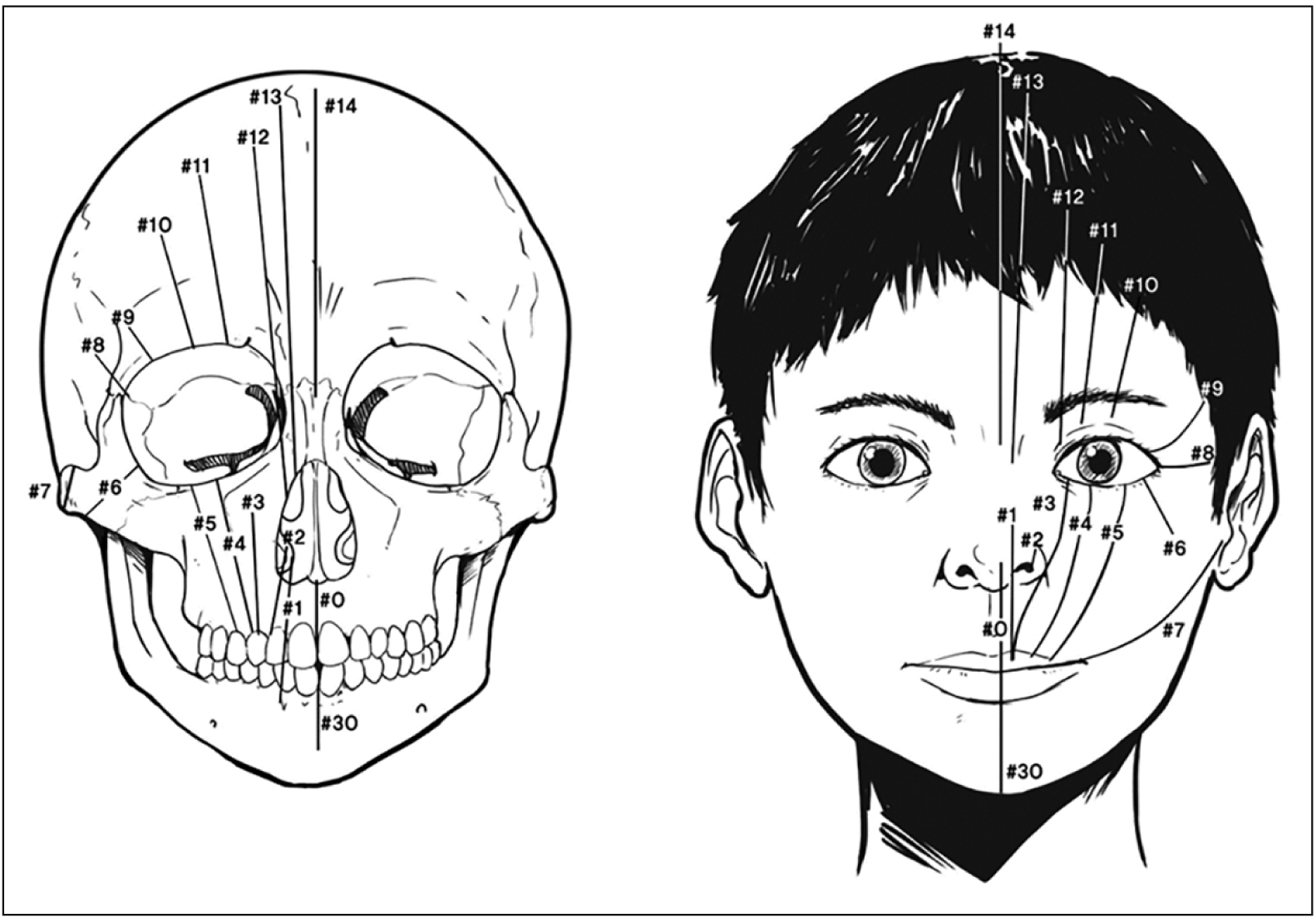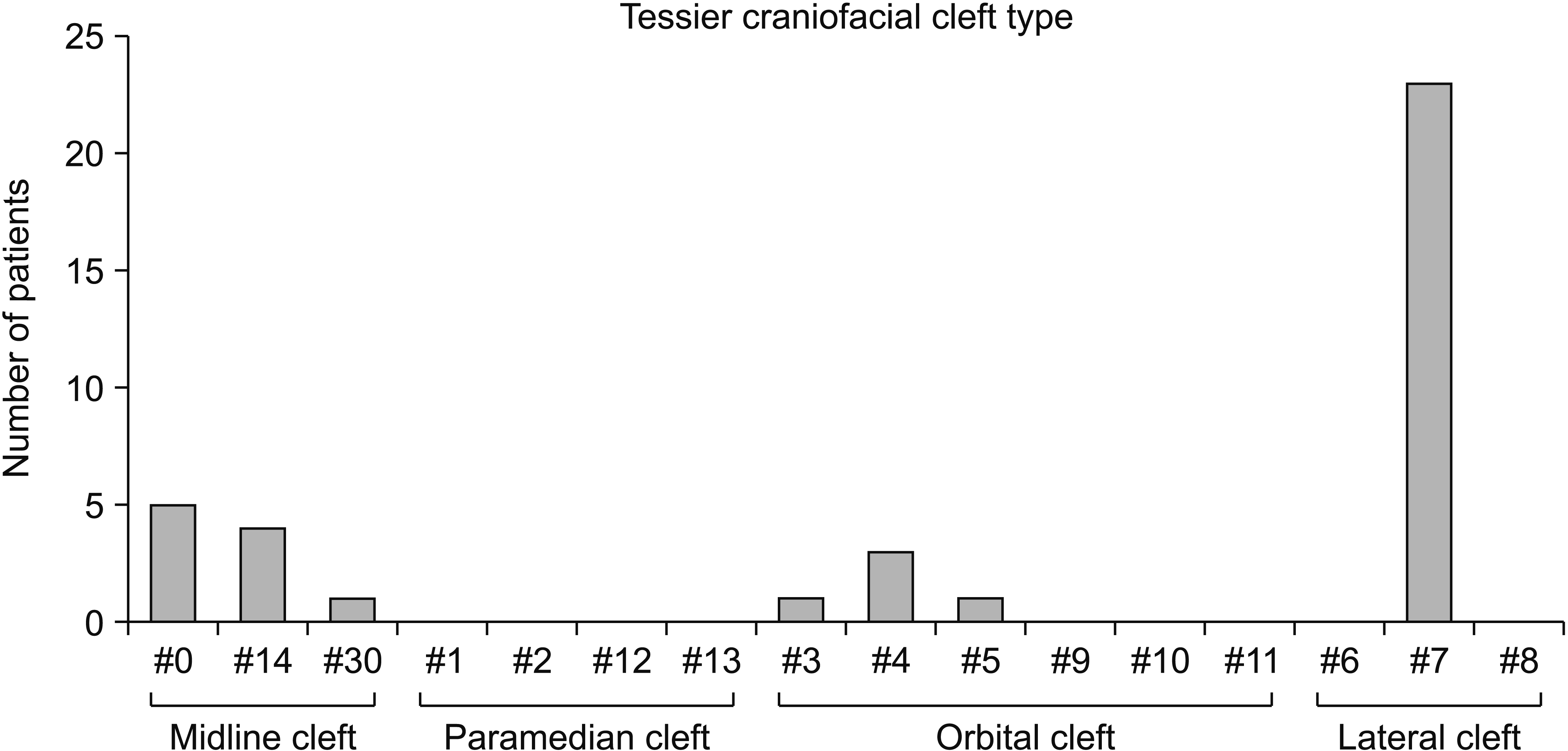1. Tobiasen JM, Levy J, Carpenter MA, Hiebert JM. 1987; Type of facial cleft, associated congenital malformations, and parents' ratings of school and conduct problems. Cleft Palate J. 24:209–15. PMID:
3477342.
4. Bütow KW, Botha A. 2010; A classification and construction of congenital lateral facial clefts. J Craniomaxillofac Surg. 38:477–84. DOI:
10.1016/j.jcms.2010.02.007. PMID:
20303283.

5. Racz C, Dakpé S, Kadlub N, Testelin S, Devauchelle B, Rachwalski M, et al. 2018; Phenotypic spectrum of Tessier facial cleft number 5. J Craniomaxillofac Surg. 46:22–7. DOI:
10.1016/j.jcms.2017.10.012. PMID:
29239768.

6. David DJ, Moore MH, Cooter RD. 1989; Tessier clefts revisited with a third dimension. Cleft Palate J. 26:163–84. discussion 184–5. PMID:
2503273.
7. Fogh-Andersen P. 1967; Genetic and non-genetic factors in the etiology of facial clefts. Scand J Plast Reconstr Surg. 1:22–9. DOI:
10.3109/02844316709006555.

9. Johnston MC. McCarthy JG, editor. 1990. Embryology of head and neck. Plastic surgery. Volume 4, cleft lip and palate and craniofacial anomalies. Saunders;Philadelphia: p. 2451–95.
10. Murray JC. 1995; Face facts: genes, environment, and clefts. Am J Hum Genet. 57:227–32. PMID:
7668246. PMCID:
PMC1801562.
12. Bradley JP, Hurwitz DJ, Carstens MH. Mathes SJ, Hentz VR, editors. 2006. Embryology, classifications, and descriptions of craniofacial clefts. Plastic surgery. Vol. 4, pediatric plastic surgery. 2nd ed. Saunders;Philadelphia: p. 15–43.
13. Kalantar-Hormozi A, Abbaszadeh-Kasbi A, Goravanchi F, Davai NR. 2017; Prevalence of rare craniofacial clefts. J Craniofac Surg. 28:e467–70. DOI:
10.1097/SCS.0000000000003771. PMID:
28678141.

14. Kawamoto HK. McCarthy JG, editor. 1990. Rare craniofacial clefts. Plastic surgery. W.B. Saunders;Philadelphia: p. 2952–5.
16. Ozaki W. Lin KY, Ogle RC, Jane JA, editors. 2002. Craniofacial clefting. Craniofacial surgery: science and surgical technique. W.B. Saunders;Philadelphia: p. 309–31.
17. da Silva Freitas R, Alonso N, Shin JH, Busato L, Ono MC, Cruz GA. 2008; Surgical correction of Tessier number 0 cleft. J Craniofac Surg. 19:1348–52. DOI:
10.1097/SCS.0b013e318184326e. PMID:
18812861.

18. Spolyar JL, Hnatiuk M, Shaheen KW, Mertz JK, Handler LF, Jarial R, et al. 2015; Tessier No. 3 and No. 4 clefts: sequential treatment in infancy by pre-surgical orthopedic skeletal contraction, comprehensive reconstruction, and novel surgical lengthening of the ala base-canthal distance. J Craniomaxillofac Surg. 43:1261–8. DOI:
10.1016/j.jcms.2015.06.002. PMID:
26170000.

20. Speltz ML, Richman L. 1997; Progress and limitations in the psychological study of craniofacial anomalies. J Pediatr Psychol. 22:433–8. DOI:
10.1093/jpepsy/22.4.433. PMID:
9302842.
21. Kim SH, Jeon JY, Bae YC, Kim SS. 1998; A clinical study on the Tessier classification No.7 cleft patient. J Korean Soc Plast Reconstr Surg. 25:243–51.
23. Son HD, Oh K, Lee KC, Park JM, Kim JT, Kim SK. 2001; Clincal Experience of the median mandibular facial cleft. J Korean Cleft Palate-Craniofac Assoc. 2:139–42.
24. Lee JH, Lee KC, Park JM, Kim SK. 2004; Postoperative analysis of the Tessier classification No.7 cleft patient. J Korean Cleft Palate-Craniofac Assoc. 5:24–30.
25. Park YT, Kye JY, Kim SG, Kwon KJ, Park YW. 2010; Tessier No. 2 oblique facial cleft not associated with cleft lip or palate: a case report. J Korean Assoc Maxillofac Plast Reconstr Surg. 32:600–3.
26. Bae YC, Kang KD, Kim KH. 2011; Alteration in surgical technique of Tessier classification number 7 cleft. Arch Plast Surg. 38:143–7.
27. Nam SM, Kim YB. 2014; The Tessier number 14 facial cleft: a 20 years follow-up. J Craniomaxillofac Surg. 42:1397–401. DOI:
10.1016/j.jcms.2014.03.032. PMID:
24837484.

28. Baek SH, Park YH, Chung JH, Kim S, Choi JY. 2018; Orthodontic and orthopedic treatment for a growing patient with Tessier number 0 cleft. Korean J Orthod. 48:113–24. DOI:
10.4041/kjod.2018.48.2.113. PMID:
29564221. PMCID:
PMC5854881.

30. Ryu JY, Eo PS, Tian L, Lee JS, Lee JW, Choi KY, et al. 2019; Surgical correction for Tessier number 7 craniofacial cleft using a medially overcorrected design. Arch Plast Surg. 46:16–22. DOI:
10.5999/aps.2018.01193. PMID:
30685937. PMCID:
PMC6369056.

31. van der Meulen JC, Mazzola R, Vermey-Keers C, Stricker M, Raphael B. 1983; A morphogenetic classification of craniofacial malformations. Plast Reconstr Surg. 71:560–72. DOI:
10.1097/00006534-198304000-00022. PMID:
6828591.

32. Portier-Marret N, Hohlfeld J, Hamedani M, de Buys Roessingh AS. 2008; Complete bilateral facial cleft (Tessier 4) with corneal staphyloma: a rare association. J Pediatr Surg. 43:e15–8. DOI:
10.1016/j.jpedsurg.2008.05.016. PMID:
18926197.

33. Alonso N, Freitas Rda S, de Oliveira e Cruz GA, Goldenberg D, Dall'oglio Tolazzi AR. 2008; Tessier no. 4 facial cleft: evolution of surgical treatment in a large series of patients. Plast Reconstr Surg. 122:1505–13. DOI:
10.1097/PRS.0b013e318188209c. PMID:
18971735.

34. Kuriyama M, Udagawa A, Yoshimoto S, Ichinose M, Suzuki H. 2008; Tessier number 7 cleft with oblique clefts of bilateral soft palates and rare symmetric structure of zygomatic arch. J Plast Reconstr Aesthet Surg. 61:447–50. DOI:
10.1016/j.bjps.2006.05.019. PMID:
18358436.

35. Mishra RK, Purwar R. 2009; Formatting the surgical management of Tessier cleft types 3 and 4. Indian J Plast Surg. 42 Suppl(Suppl):S174–83. DOI:
10.1055/s-0039-1699391. PMID:
19884673. PMCID:
PMC2825067.

36. da Silva Freitas R, Alonso N, Shin JH, Busato L, de Oliveria e Cruz GA, Dall'Oglio Tolazzi AR. 2009; The Tessier number 5 facial cleft: surgical strategies and outcomes in six patients. Cleft Palate Craniofac J. 46:179–86. DOI:
10.1597/07-192.1. PMID:
19254060.

38. Woods RH, Varma S, David DJ. 2008; Tessier no. 7 cleft: a new subclassification and management protocol. Plast Reconstr Surg. 122:898–905. DOI:
10.1097/PRS.0b013e3181811cb6. PMID:
18766056.

39. Cheung LK, Samman N, Tideman H. 1993; Bilateral transverse facial clefts and accessory maxillae--variant or separate entity? J Craniomaxillofac Surg. 21:163–7. DOI:
10.1016/S1010-5182(05)80106-4. PMID:
8335728.





 PDF
PDF Citation
Citation Print
Print








 XML Download
XML Download